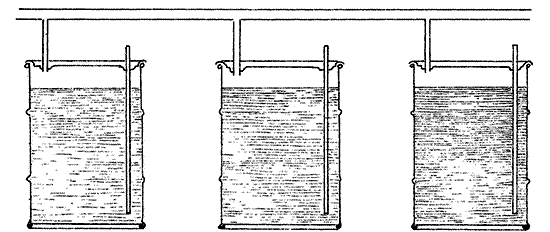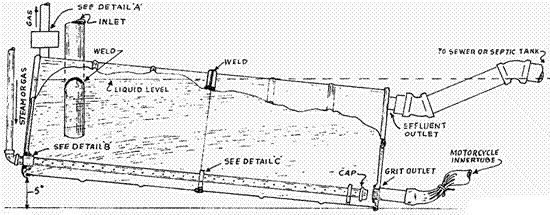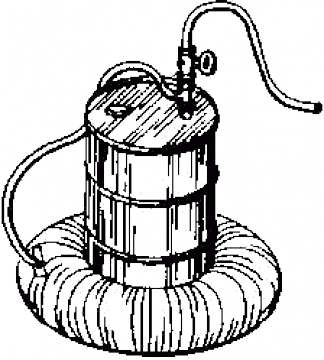In small– and micro–scale biogas, one of the classic approaches is to use 55– (or 30–) gallon drums, in one configuration or another, to make a digester. Indeed many have done it (e.g. Larry Romesberg), and in fact there is a good deal of information about 55-gallon drum digesters (some of which are quite interesting) in The Complete Biogas Handbook (TCBH): but four important points should be made:
First of all, realize that as a general rule, a digester kept warm and well-fed will produce its own volume in biogas every day. So think about the fact that fifty-five gallons of biogas is ~7.3 ft3, ~200 liters. A single burner stove, depending on a number of factors, will consume about twice that much biogas every hour, meaning that one has to generate biogas out of a 55-gal drum (kept warm!) for a full day in order to run a single-burner stove for a half hour. Therefore this is the first point:
- 55-gallon drum digesters made from one drum are usually just too small to produce practical amounts of biogas. Fine for experimenting; probably not much help with living.
One can produce more biogas by “ganging” drums together, as shown below, but the key difficulty, as we implied above, is that to get much biogas out of a digester, it has to be kept warm (the temperature of your gut is our aim). Any digester can of course be warmed (gain heat) from the sun or air on its surface, but where the weather is not in the optimal range— the ‘mesophilic’ range, 70° to 104°F, 21° to 40°C— the digester will also lose heat from all of its surfaces, and practically speaking, that makes it harder to retain heat because (say) four 55-gallon drums will have a lot more surface area than one 200+ gallon container. For most of the world, above or below the equatorial belt or at high altitude (Europe, the US, the better part of Asia, Australia and little New Zealand: Antarctica!) that kind of weather is only available on occasional days for a few months a year, if ever. Therefore this is the second point:
- Digesters made from 55-gallon drums require more heat/energy input to maintain a given temperature in the digester(s) as compared with the same volume in a larger container; and for many of us, digesters are hard enough to keep at an optimal temperature as it is.

It’s not easy to build a continuous-fed digester when starting with a 55-gallon drum. TCBH has a design that does it— pg. 215; and see below. That means— just in case it’s not obvious already— that most digesters made from 55-gallon drums will be batch-fed; they will have to be filled, they will generate biogas for a couple of months (maybe), and they will then have to be emptied. That may sound like no big deal, but don’t forget that a 55-gallon drum filled with anything that will actually make biogas will weigh about 420 pounds, 190 kg, or more. (How much weight can you bench press?) As an example of a digester design using multiple 55-gallon drums yet which fails to mention the considerable difficulty of wrestling with them, consider this one.
The point is that once you fill it up, you may not be able to empty that 55-gallon drum without some kind of mechanical assistance. Many people would not even be able to push it over, if it was on a stable base. Do you own a tractor?
And if somehow you find out you can push them over, and all that… stuff… comes out of them right where they are because you simply couldn’t move them more than two feet… Will that be the right place for the stuff? (We call that stuff “effluent” in the biogas business, by the way.)
So this is the third point:
- Digesters made from 55-gallon drums may be damn inconvenient to work with.

This image/design from The Complete Biogas Handbook was used on the cover of a VITA publication called “Understanding Biogas Generation”, and may well have served as the basis for a design by ECHO (discussed here.) Another continuous-fed design using drums is very briefly described in this publication.
And finally, although more might be said about this subject, let me say that in my area of the world (northern Oregon, USA), free drums are not easily found, and the other kind— the kind you have to pay for— cost at least $10, often more. Considering some of the other alternatives mentioned below, this leads us to make the final, perhaps surprising point about digesters made using 55-gallon drums:

- On a per volume basis, digesters made from 55-gallon drums can be relatively expensive.
Recommendation: Perhaps the classic reference with regard to making a digester out of a 55-gallon drum is from the United Nations’ Food and Agriculture Organization (FAO), “Biogas 2: Building a better biogas unit” (pub. 1986), one version of which is found here. (You may also want to get the publication previous to this one, called “Biogas: What it is, How it is made; How to use it”.)
| Next: | How to build an ARTI-style digester |
| Previous: | How to build a small biogas digester (intro) |

